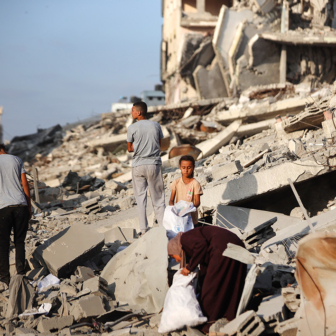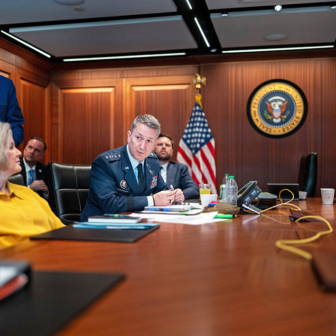Means, motive and opportunity overwhelmingly suggest that the 4 April chemical weapons attack on Khan Sheikhun was the work of Bashar al-Assad’s regime, in breach of the commitments it made after an earlier round of chemical attacks in 2013. But the US government’s hastily assembled retaliatory attack on the Shayrat airbase is unlikely to prove effective in depriving the regime of its residual nerve agents.
This is not to argue that the American attack was reckless or high-risk. It could have been much more effective, though, if it had been more carefully planned and executed. Damage to the base was not extensive and the Assad regime has endured worse humiliations. The fact that president Donald Trump may have been partly motivated by a desire to be seen as decisive may have worked against the effective use of military power for defined ends.
Chlorine has been used as a weapon in Syria on several occasions since 2013, and not just by the government. But Assad’s decision to resort once again to binary chemical agents, such as sarin, represents an open defiance of the norms it agreed to be bound by under the inspection-and-disposal program overseen by the Organisation for the Prohibition of Chemical Weapons, or OPCW, and underwritten by Russia. For the outside world to turn a blind eye to use of the same weapons would amount to standing with arms folded while the level of savagery in this conflict rose to new heights.
Although the Syrian armed forces are the likely perpetrators, an independent assessment is vital in underlining the seriousness of the red line the regime has crossed. Reports relayed via Syrian opposition forces, particularly those close to al Qaeda, or by the Turkish authorities should be counter-checked carefully before being recounted.
Doubts have been raised as to whether the Syrian regime would have been bent on self-destruction so soon after its retaking of Aleppo on 6 December last year. But this is a total misreading of what is happening on the ground. The Syrian conflict has one key theme: the regime has huge difficulties in holding terrain because of two things: the poor quality of its conscript-based armed forces, and the capacity of its opponents to crop up almost at will, crossing the vast central steppe to suddenly appear in inhabited areas around the western rim and in the Euphrates River valley.
This misreading has been on vivid display in the news media’s reporting since Aleppo fell, which has overlooked numerous firefights along the southern rim of Idlib province, where Islamist fighters have been dumped following “ceasefire” deals concluded in and around Aleppo, Damascus and Homs. These fiercely committed forces (mainly al Qaeda offshoots) have been resupplied across the Turkish border and have begun pressing south towards the next provincial capital, Hama.
Hama is one of a handful of Syrian cities to have remained relatively quarantined from the conflict. It is no coincidence that it was the final battleground in the Muslim Brotherhood’s rebellion against the government thirty-five years ago. The punishment meted out in the regime’s bombardment of the city in 1982 was so brutal and decisive that Hama has remained in clampdown ever since. If Hama can be drawn directly into the struggle, the regime will suffer a moral loss that would more than outweigh the victory it has claimed in Aleppo.
The skirmishes over the past month in the Orontes Valley rim area between Hama and Idlib thus pose a new challenge to the government. Rather than Assad’s being on a high – and therefore concerned not to offend the community just as he hoped to be acknowledged as a winner – he was possibly experiencing the opposite, more like panic. The risk is that he might choose to echo his father’s brutal razing of central Hama. And being tough in the face of a US president who seems to have no stabilising principles (and is isolationist at heart) might seem like an opportunity not to be lost.
The probability is that Assad saw the chemical attack as a means of discouraging any drive by Islamist forces towards Hama. The Russians’ counter-claim – attempting to pin the incident on the town’s rebels, who were said to have concocted sarin in an empty shed – simply signals that there is no credible alternative explanation and that the Russians might have been caught flat-footed. Assad may not have told the Russians he was scrapping the 2013 agreement they underwrote, though it could not have escaped their notice given their shared use of the base at Shayrat.
Trump has promised a strategy, but does he have the makings of one? The OPCW admits that 5 per cent of identified chemical weapons have still not been accounted for. Trump’s improvised rhetoric tried to give the impression that the Shayrat raid addressed that problem. But the fact is that it was Obama’s measured working through of the options (now endlessly recycled as an example of irresolution) that saw the removal of 95 per cent of the nerve agents held in Syria. The Shayrat raid has done nothing to neutralise the other 5 per cent, sufficient for a few more Khan Sheikhuns. Obama had the credibility to engage the Russians in the OPCW process; Trump seems intent on using Khan Sheikhun to shake off the charge that he has been soft on Putin.
The only way of replacing Assad is to engage Russia (and Iran) in the process. Getting rid of Islamic State still remains the logical first objective in the fighting. Will Assad provide further distractions to taunt Trump, demonstrating that the president of Syria still calls the tune? He has never given any indication that he cares how long the war lasts and how many more die in agonising circumstances. He seems determined to wait out all his opponents.
Perhaps, though, Assad needs to be more careful with his friends. Moscow must wonder whether it should have him on a tighter lead. Trump, meanwhile, plays a dangerously short-term game, obsessed with old animosities, driven by impulses and uninterested in strategy, preferring the one-off deal. Given the big battles that still await Syria in Idlib province and around Raqqa, the conflict’s capacity to regenerate itself stretches on endlessly. Shayrat was barely a blip on that horizon. •




